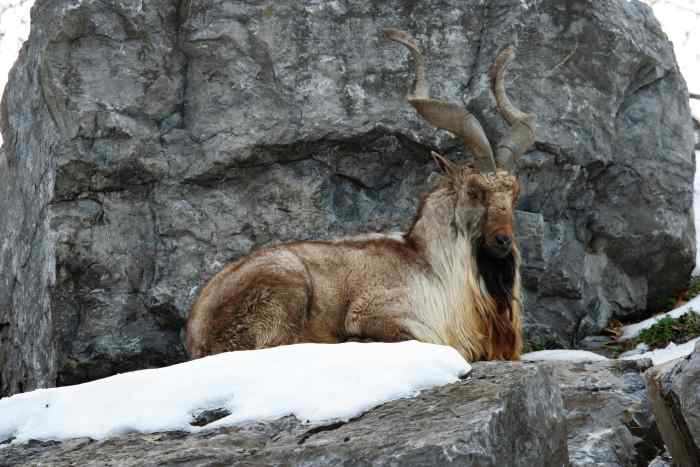1. The Markhor is the Largest of the Goat Family
The markhor (Capra falconeri) is a large wild goat of the family Bovidae and order Artiodactyla. Of the goats, they are the largest, measuring as much as 52-74 inches (132-186 centimeters) in length, and they stand 26-45 inches (65-115 centimeters) high. They weigh between 88 and 240 pounds (40-110 kilograms).
There is a marked difference between males and females. The males can be as much as twice the size and are often thought to be massive. They also have more hair on their chin and chest, and their horns are much longer. Males also tend to be a lighter shade of tan than their female counterparts.
2. Their Most Notable Marking are Their Corkscrew Horns
Although, in many ways, they look like others in the goat family, with their tan coats and white underparts, their most notable feature is their long spiraled horns. Males have much longer horns than females. Their horns can measure up to 63 inches (160 centimeters), while the female's horns measure only 9.8 inches (25 centimeters). The way the horns are shaped and displayed is dependent on what subspecies of markhor. Some are straighter, while others may flare outward from their heads.
3. There Are Three Subspecies of Markhors
The three subspecies include the flare-horned markhor (or Astor), the straight-horned markhor (or Kabul), and the Bukharan markhor. The most significant difference between each is that of their horns.
Flare-horned markhors horns split and spread out in two different directions, reminiscent of an open banana peel. They live in India, Pakistan, and Afghanistan.
Just as its name suggests, the straight-horned markhor has horns that go straight up. Their horns still have the same corkscrew shape, just like other markhors. They mainly live in Pakistan and Afghanistan.
The Bukharan markhors have the most impressive horns and are what most people think of if they are thinking of these magnificent beasts. They live in Afghanistan, Tajikistan, Turkmenistan, and Uzbekistan.
4. Markhors Use Their Horns for Fighting to Win a Mate
Their corkscrew-shaped horns are often used to dig for food, remove bark from trees, and even have rings in them like a tree to tell how old a markhor is. The males also use their long horns to win a female during the mating season by butting heads with other males they encounter. They will twist and turn their heads until one male falls and loses the match.
The mating season occurs during the winter. Once pregnant, the females will deliver after 135-170 days, which is about half of the gestational period of a human. They will give birth to one or two young called kids. They wean their young at 5-6 months but are not considered mature until about 18-30 months, females maturing sooner than males. Most markhors will live about 12-13 years.










0 Comments